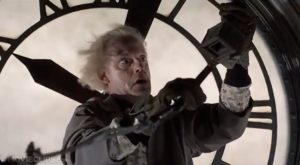Back to the Future is arguably one of the most popular films ever made. It’s in my own top ten, and in in virtually every list of cinema top movies. the script is regarded as a prime example of how to structure a screenplay, and it’s taught in scriptwriting classes in universities across the US. But it’s not perfect, and ths is why.
Understand, I say this with great respect for the script, the direction, and the finished film. But Bob Gale and Robert Zemeckis made some interesting story and character choices. I’m not talking about inconsistencies, or inadvertent goofs (like the fact that Doc Brown has absolutely no way to get into the DeLorean that he backs out of the truck in its first appearance). I’m talking about story arcs and character arcs over the course of the film.
There’s no arguing that Marty is the main protagonist in BTTF. He’s the principal character and drives much of the action. Usually this would also make him the hero. But, and I’m bending the concept to make the point, Marty’s character doesn’t change or grow during the movie. At the end he’s pretty much the same as he is at the beginning. While a protagonist doesn’t have to change to be the hero of a story (James Bond is a prime example), for my purpose I’m saying that Marty does not grow in BTTF, so he’s not the story’s true hero. Other characters grow in ways that I regard as heroic. They are the real heroes of Back to the Future.
You already know this if you think about it. Who changes over the course of the movie? Who grows? Who becomes a better example of what it can mean to be human, the core theme of all stories?
Yep, it’s George. He changes so much that his appearance at the beginning and end of the movie is like night and day. You can pinpoint the exact moment George becomes a hero:
Yep—the punch. This is the moment that George changes emotionally and fundamentally. It’s a moment so good, so satisfying, that they revisited it in Back to the Future II. Never mind that George almost wimped out on the dance floor a few minutes later—the dance scene was simply a good plot device to show that George’s character change was permanent—not just a momentary action.
I would argue that there is a possible second hero in BTTF: Doc Brown. It’s subtle, and you need to rely on the viewer’s perception of the Doc and his actions, but we can pinpoint the moment Doc Brown becomes a hero.

The moment that Doc makes the determination to plug in the lightning bolt cablecable and ride it zipline-style to the ground and make the final connection is when he becomes a hero. You can see the change in his face as he determines to do whatever is needed to connect the cable and get Marty home. I would also say that his demeanor at the end of the movie, more grounded and less “crackpot” than in the film’s beginning, also speaks to the change in Doc’s character. Yes, it’s not as strong a case as George, but part of any created work is how others view it. I choose to view Doc as a hero who grows over the course of the movie, and I stand by it.
We can discuss the glaring plot and character points of the second and third Back to the Future installments, but that’s for another post.
Leave a Reply